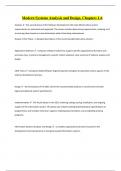Modern Systems Analysis and Design, Chapters 1-6
Analysis ✔️the second phase of the Software Development Life Cycle (SDLC) where system
requirements are examined and organized. This phase includes determining requirements, studying, and
structuring them based on interrelationships while eliminating redundancies.
Output of this Phase = a detailed description of the recommended alternative solution.
Application Software ✔️computer software tailored to support specific organizational functions and
processes (e.g., inventory management, payroll, market analysis); a key outcome of systems analysis and
design.
CASE Tools ✔️Computer-Aided Software Engineering tools designed to automate certain aspects of the
systems development process.
Design ✔️the third phase of the SDLC where the recommended solution is transformed into both
logical and physical system specifications.
Implementation ✔️the fourth phase in the SDLC involving coding, testing, installation, and ongoing
support of the information system. This phase also entails handing detailed physical specifications to
programmers and includes initial user support, finalizing documentation, and completing training
programs.
Information Systems Analysis and Design ✔️a complex organizational process focused on the
development and maintenance of computer-based information systems.
,Inheritance ✔️the property in object-oriented programming where entity types or classes are
organized in a hierarchy, allowing derived classes to inherit attributes and methods from their ancestors,
thereby facilitating the creation of new, related classes.
Logical Design ✔️the segment of the design phase in the SDLC that describes all functional features of
the selected system independently of any specific technology, ensuring that the system meets business
requirements.
Maintenance ✔️the final phase in the SDLC that involves systematically repairing and enhancing the
information system, addressing user requests and adapting the system to reflect changing business
conditions.
Object ✔️an encapsulation of attributes and methods that represent real-world entities; an abstraction
that models the structure and behavior of a thing, combining data and functionalities.
Object Class ✔️a classification of objects sharing similar attributes and behaviors (methods).
OOAD ✔️Object-Oriented Analysis and Design, methodologies focused on system development based
on objects rather than processes or data; often referred to as the third approach to systems
development alongside process-oriented and data-oriented methods.
Physical Design ✔️the segment of the design phase where the logical specifications from the logical
design are converted into technology-specific details for programming and system construction.
Planning ✔️the first phase in the SDLC where an organization identifies, analyzes, prioritizes, and
organizes its total information system needs.
, Rapid Application Development (RAD) ✔️a systems development methodology aimed at significantly
reducing the time required to design and implement information systems, emphasizing user
involvement, prototyping, integrated CASE tools, and code generation.
Rational Unified Process (RUP) ✔️an object-oriented systems development methodology comprising
four phases: inception, elaboration, construction, and transition, with each phase encompassing several
iterations.
Systems Analyst ✔️the key organizational role responsible for analyzing and designing information
systems, primarily focused on understanding organizational problems and needs to effectively integrate
people, methods, and technology for improvement.
SDLC ✔️the traditional methodology employed for developing, maintaining, and replacing information
systems.
Systems Development Methodology ✔️the structured process followed within an organization to
analyze, design, implement, and maintain information systems.
Cloud Computing ✔️the delivery of computing resources, including applications, over the internet,
enabling customers to utilize resources without the need for substantial hardware and software
investments.
Enterprise Resource Planning (ERP) ✔️a system that integrates various traditional business functions
into a cohesive set of modules, allowing for seamless operations within a unified information system.




